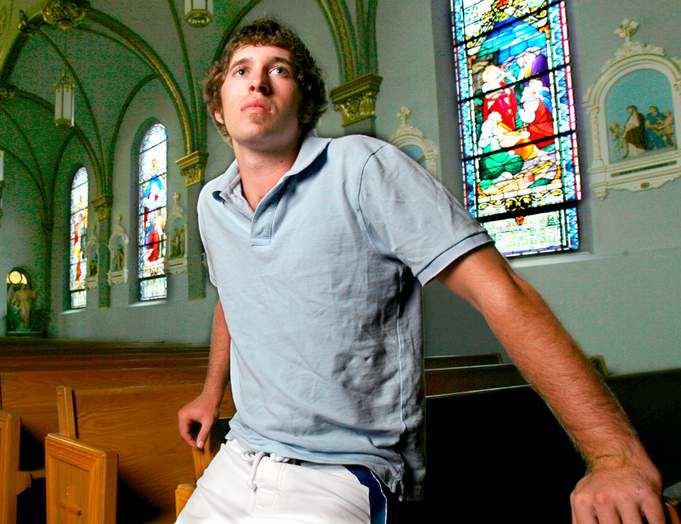Young man’s recovery may put Kansas chaplain on the road to sainthood
Published 5:00 am Thursday, July 16, 2009

- When Chase Kear fractured his skull, residents of Colwich, Kan., prayed to Father Emil Kapaun, a local priest and Korean War chaplain, for his recovery.
COLWICH, Kan. — On the first day — long before the lawyer from the Vatican showed up, long before talk of saints and miracles — young Chase Kear lay on the edge of death in the intensive care unit.
It was an accident: pole vaulting. The 19-year-old athlete’s skull was cracked from ear to ear across his forehead. His bleeding brain swelled. Machines hummed and beeped. Tubes jutted from his nose, mouth and veins.
Trending
Dozens of family and friends flocked crying to the St. Francis campus of Wichita’s Via Christi Regional Medical Center to wrap Chase’s parents, Paul and Paula Kear, in their arms and prayers.
It is to whom they prayed that is part of the wonder of the thing.
The supplications went to an Army chaplain — a local priest martyred long ago by the cold and brutality of a POW camp in North Korea.
The aura surrounding the late Father Emil Kapaun and his deeds is only strengthened by Chase’s story. “It was miraculous,” Chase’s neurosurgeon, Raymond Grundmeyer, later would write.
Now the Catholic Church must seriously ponder: Should a new member from the Kansas prairie join its pantheon of Catholic saints?
Against the odds
Trending
“God won’t do this to our family twice,” one of Paula Kear’s sisters assured her. Fifteen years ago, the sister had lost her 16-year-old son when he climbed a tree and grabbed a power line.
Now this: the withering call on Oct. 2, 2008. “There’s been an accident,” Chase’s coach said.
Chase had been a state-ranked vaulter at Andale High School. He was in the second year of a track scholarship at Hutchinson Community College, 35 miles from home.
But on this autumn day, Chase felt something different when he launched. The pole had more energy. It propelled him too far. His rear end caught the edge of the mat. His torso snapped back, whipping his skull to the ground.
“It’s bad,” the coach told Paula. She could hear the womp the helicopter landing to speed her unconscious son to Wichita. “It’s real bad.”
At the hospital, a chaplain led them to a tiny conference room. Paula’s older sister, Linda Wapelhorst, sat nearby. She would quietly request that a priest enter Chase’s room and perform the Catholic sacrament of last rites.
“She asked us if we wanted her to call our parish, Sacred Heart,” Paula recalled, “and put Chase on the prayer line and pray the prayer to Father Kapaun.”
That, some said, is when the miracle began. Because seven weeks later — against all medical odds and his doctors’ abilities to explain it — Chase Kear came back.
Is it a miracle?
“Hey, hi,” Chase, now 20, said cheerfully last week. He swung open the front door of his family’s home.
He wears his hair long to cover the scar from his surgeon’s last-ditch effort to save his life. That involved removing a saucer-sized hunk of his skull to reduce the pressure on his brain.
“I feel good,” he said to the obvious question and introduced his parents in a living room where framed prayers and crucifixes adorned the walls.
It’s also where the postulator from the Vatican, Andrea Ambrosi, came to talk. It is his task to collect evidence and present the cases of would-be saints back in the halls of St. Peter’s.
The Catholic Diocese of Wichita has offered Chase’s case as miraculous healing brought on by thousands of prayers to the late priest Emil Kapaun, whom the diocese hopes to see canonized.
To declare an individual a saint, the Roman Catholic Church requires proof of at least two posthumous miracles. Should the church accept Chase’s healing as divine, it would be the first miracle credited to Kapaun toward sainthood. Ambrosi is also investigating evidence of two other healings credited to Kapaun.
“He sat on my front living room couch and took his coat off and loosened his tie,” Paula, a middle school teacher, said of Ambrosi. “I’m just amazed. We’re not special people.”
But the Kears do believe something special happened to their son. And Chase believes it, too. “I was dead. Here I am now,” he said, and then of Kapaun: “I think he saved me.”
A hero and a martyr
The story of Emil Kapaun (pronounced kay-pin) is well-known in this region of Kansas, where a Catholic high school bears his name. As recently as June, 11 worshippers completed a 59-mile pilgrimage in support of the cause to make him a saint.
Born in 1916 near Pilsen, Kan., Kapaun was a priest in the Wichita diocese who volunteered to be a U.S. Army chaplain. His selfless behavior became well-known during the Korean War.
“They say his pipe was shot out of his mouth by a sniper and that didn’t stop him,” said the Rev. John Hotze, who is coordinating the effort to make Kapaun a saint.
After the 8th Cavalry Regiment stumbled into a Chinese ambush and disaster, Kapaun stayed behind with the wounded instead of joining the pell-mell retreat. Time and again, the gentle priest risked his life to keep the enemy from finishing off wounded Americans on the battlefield.
Taken prisoner, he suffered with other GIs in a camp of squalor and deprivation along the Yalu River. In the bitter winters of 1950 and 1951, hundreds would die of starvation and illness. Kapaun stole food to keep others alive before his own death from pneumonia after about six months as a prisoner.
The U.S. Army awarded him the Distinguished Service Cross. Even now, former prisoners are making a case for awarding him the Medal of Honor.








